Managing Innovation in Business: Vodafone UK Case Study Report
VerifiedAdded on 2022/11/25
|12
|3016
|496
Report
AI Summary
This report examines the innovation management of Vodafone UK (formerly BT), a major telecommunications company. It begins with an executive summary and introduction, highlighting Vodafone's historical innovations and current strategies. The main body provides an overview of the organization and the telecommunications industry, focusing on Vodafone's existing innovation performance and capabilities, including fiber broadband, 5G technologies, artificial intelligence, and partnerships. The report also analyzes the telecommunications industry in 2016, discussing data importance, 4G growth, and emerging opportunities such as IoT and government sector initiatives. The report concludes by summarizing key findings and the future outlook of the company. The report uses information from 2016.
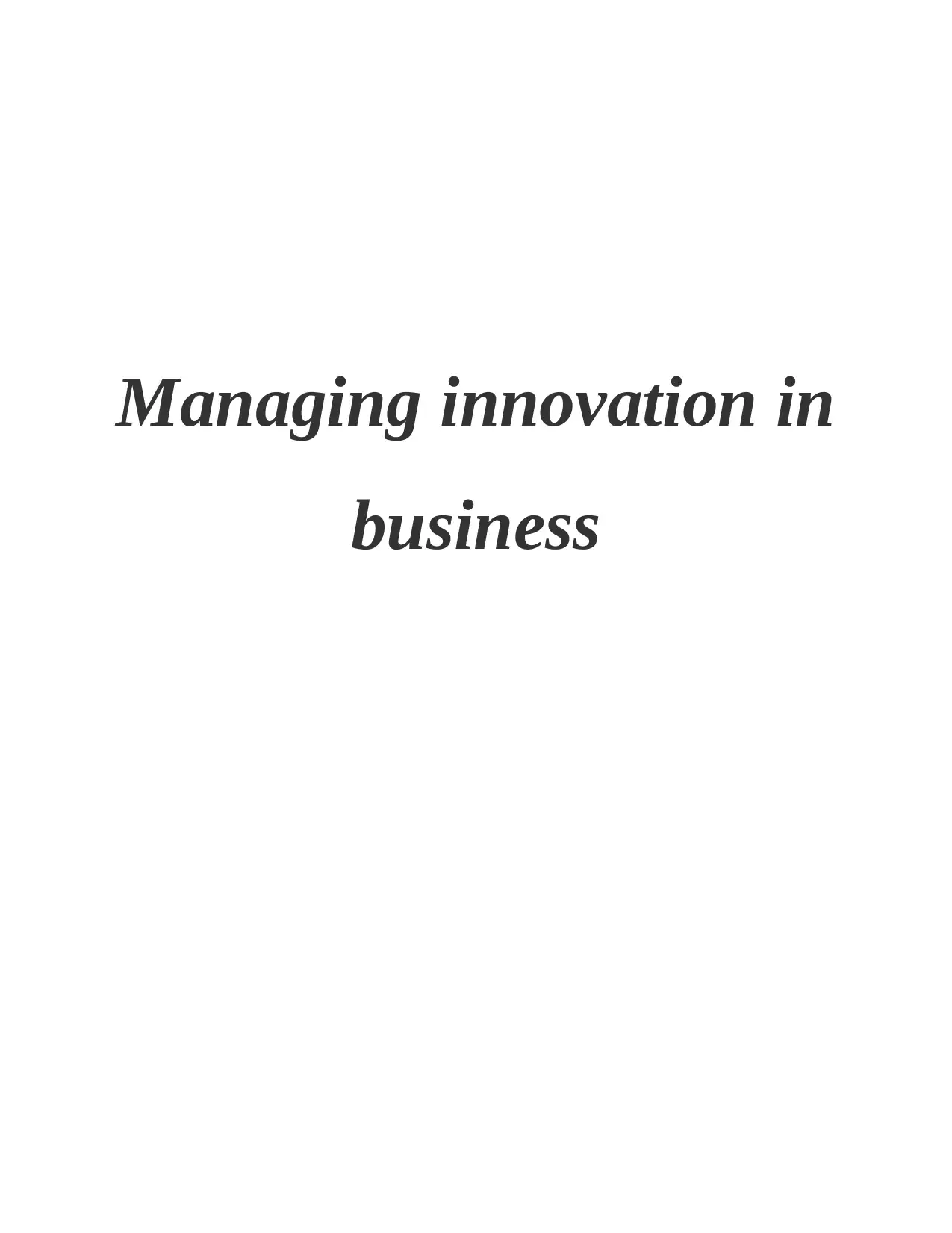
Managing innovation in
business
business
Paraphrase This Document
Need a fresh take? Get an instant paraphrase of this document with our AI Paraphraser


Executive Summary
The company that used to be known as Vodafone UK is already known as BT. This is one of the
biggest telecommunication services firms in the globe. BT's innovations having made a significant
contribution to the development of the contemporary age during the last 170 years. As part of a fresh
corporate image, the corporation changed names to VODAFONE on April 2, 1991.
The company that used to be known as Vodafone UK is already known as BT. This is one of the
biggest telecommunication services firms in the globe. BT's innovations having made a significant
contribution to the development of the contemporary age during the last 170 years. As part of a fresh
corporate image, the corporation changed names to VODAFONE on April 2, 1991.
⊘ This is a preview!⊘
Do you want full access?
Subscribe today to unlock all pages.

Trusted by 1+ million students worldwide
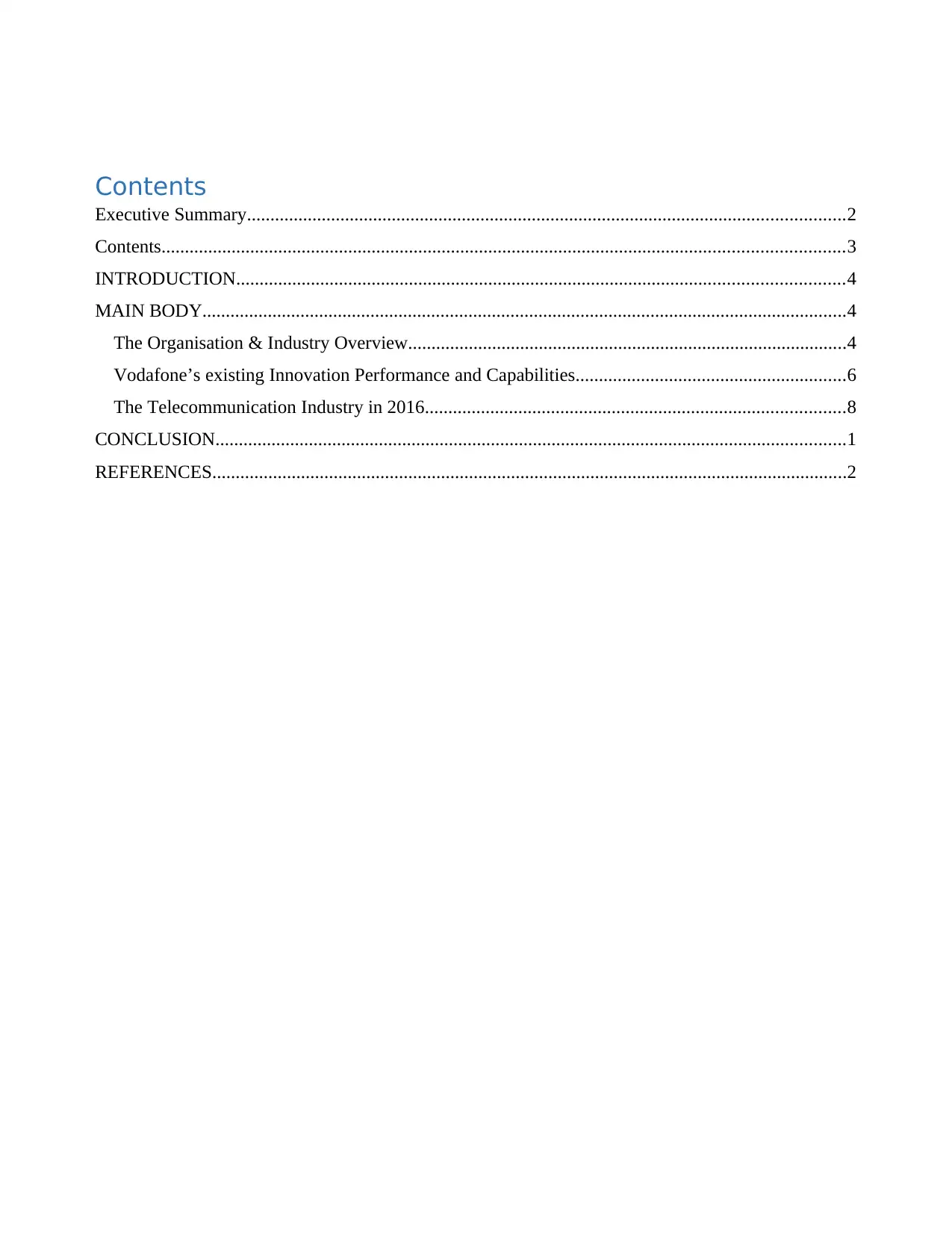
Contents
Executive Summary................................................................................................................................2
Contents..................................................................................................................................................3
INTRODUCTION..................................................................................................................................4
MAIN BODY..........................................................................................................................................4
The Organisation & Industry Overview..............................................................................................4
Vodafone’s existing Innovation Performance and Capabilities..........................................................6
The Telecommunication Industry in 2016..........................................................................................8
CONCLUSION.......................................................................................................................................1
REFERENCES........................................................................................................................................2
Executive Summary................................................................................................................................2
Contents..................................................................................................................................................3
INTRODUCTION..................................................................................................................................4
MAIN BODY..........................................................................................................................................4
The Organisation & Industry Overview..............................................................................................4
Vodafone’s existing Innovation Performance and Capabilities..........................................................6
The Telecommunication Industry in 2016..........................................................................................8
CONCLUSION.......................................................................................................................................1
REFERENCES........................................................................................................................................2
Paraphrase This Document
Need a fresh take? Get an instant paraphrase of this document with our AI Paraphraser
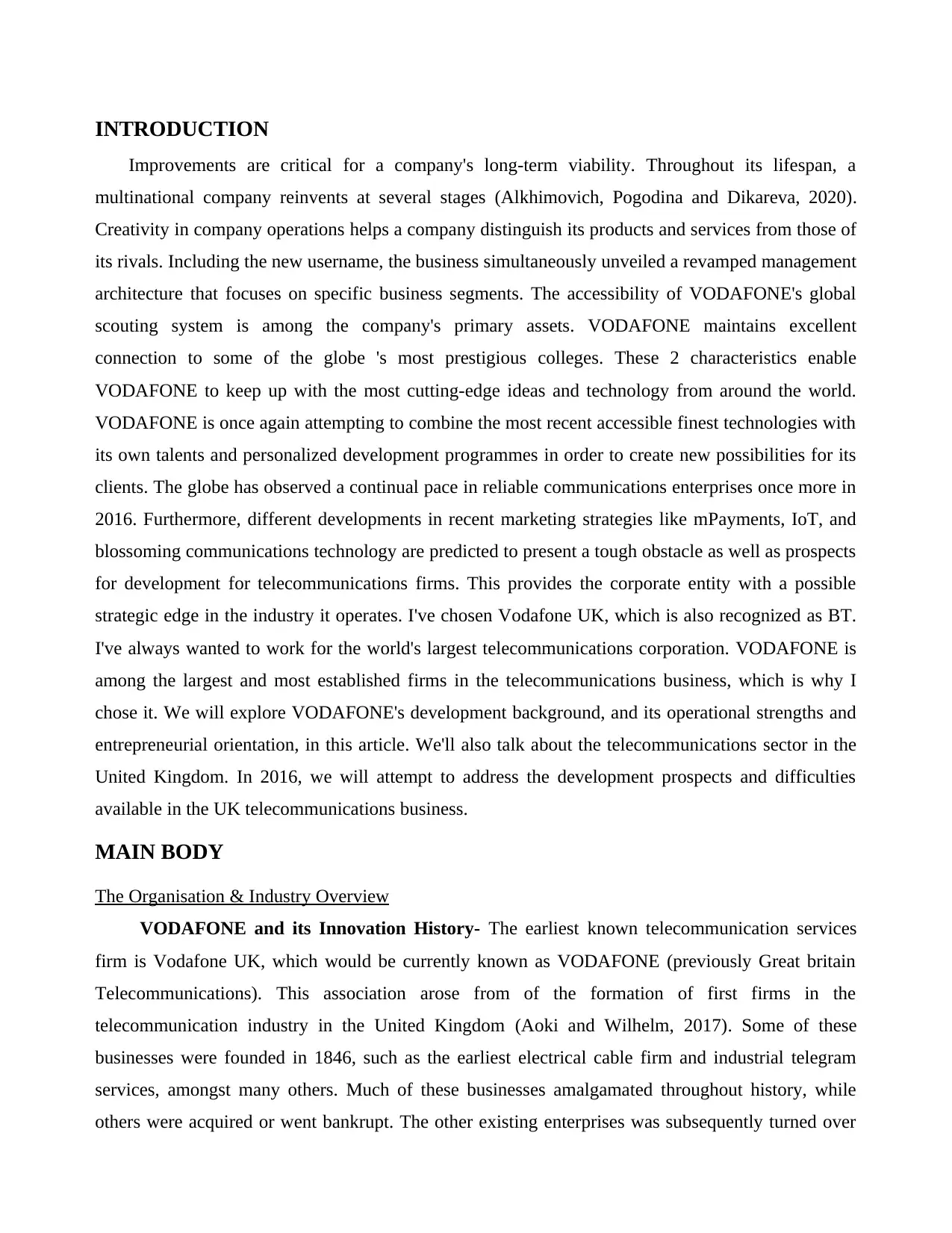
INTRODUCTION
Improvements are critical for a company's long-term viability. Throughout its lifespan, a
multinational company reinvents at several stages (Alkhimovich, Pogodina and Dikareva, 2020).
Creativity in company operations helps a company distinguish its products and services from those of
its rivals. Including the new username, the business simultaneously unveiled a revamped management
architecture that focuses on specific business segments. The accessibility of VODAFONE's global
scouting system is among the company's primary assets. VODAFONE maintains excellent
connection to some of the globe 's most prestigious colleges. These 2 characteristics enable
VODAFONE to keep up with the most cutting-edge ideas and technology from around the world.
VODAFONE is once again attempting to combine the most recent accessible finest technologies with
its own talents and personalized development programmes in order to create new possibilities for its
clients. The globe has observed a continual pace in reliable communications enterprises once more in
2016. Furthermore, different developments in recent marketing strategies like mPayments, IoT, and
blossoming communications technology are predicted to present a tough obstacle as well as prospects
for development for telecommunications firms. This provides the corporate entity with a possible
strategic edge in the industry it operates. I've chosen Vodafone UK, which is also recognized as BT.
I've always wanted to work for the world's largest telecommunications corporation. VODAFONE is
among the largest and most established firms in the telecommunications business, which is why I
chose it. We will explore VODAFONE's development background, and its operational strengths and
entrepreneurial orientation, in this article. We'll also talk about the telecommunications sector in the
United Kingdom. In 2016, we will attempt to address the development prospects and difficulties
available in the UK telecommunications business.
MAIN BODY
The Organisation & Industry Overview
VODAFONE and its Innovation History- The earliest known telecommunication services
firm is Vodafone UK, which would be currently known as VODAFONE (previously Great britain
Telecommunications). This association arose from of the formation of first firms in the
telecommunication industry in the United Kingdom (Aoki and Wilhelm, 2017). Some of these
businesses were founded in 1846, such as the earliest electrical cable firm and industrial telegram
services, amongst many others. Much of these businesses amalgamated throughout history, while
others were acquired or went bankrupt. The other existing enterprises was subsequently turned over
Improvements are critical for a company's long-term viability. Throughout its lifespan, a
multinational company reinvents at several stages (Alkhimovich, Pogodina and Dikareva, 2020).
Creativity in company operations helps a company distinguish its products and services from those of
its rivals. Including the new username, the business simultaneously unveiled a revamped management
architecture that focuses on specific business segments. The accessibility of VODAFONE's global
scouting system is among the company's primary assets. VODAFONE maintains excellent
connection to some of the globe 's most prestigious colleges. These 2 characteristics enable
VODAFONE to keep up with the most cutting-edge ideas and technology from around the world.
VODAFONE is once again attempting to combine the most recent accessible finest technologies with
its own talents and personalized development programmes in order to create new possibilities for its
clients. The globe has observed a continual pace in reliable communications enterprises once more in
2016. Furthermore, different developments in recent marketing strategies like mPayments, IoT, and
blossoming communications technology are predicted to present a tough obstacle as well as prospects
for development for telecommunications firms. This provides the corporate entity with a possible
strategic edge in the industry it operates. I've chosen Vodafone UK, which is also recognized as BT.
I've always wanted to work for the world's largest telecommunications corporation. VODAFONE is
among the largest and most established firms in the telecommunications business, which is why I
chose it. We will explore VODAFONE's development background, and its operational strengths and
entrepreneurial orientation, in this article. We'll also talk about the telecommunications sector in the
United Kingdom. In 2016, we will attempt to address the development prospects and difficulties
available in the UK telecommunications business.
MAIN BODY
The Organisation & Industry Overview
VODAFONE and its Innovation History- The earliest known telecommunication services
firm is Vodafone UK, which would be currently known as VODAFONE (previously Great britain
Telecommunications). This association arose from of the formation of first firms in the
telecommunication industry in the United Kingdom (Aoki and Wilhelm, 2017). Some of these
businesses were founded in 1846, such as the earliest electrical cable firm and industrial telegram
services, amongst many others. Much of these businesses amalgamated throughout history, while
others were acquired or went bankrupt. The other existing enterprises was subsequently turned over
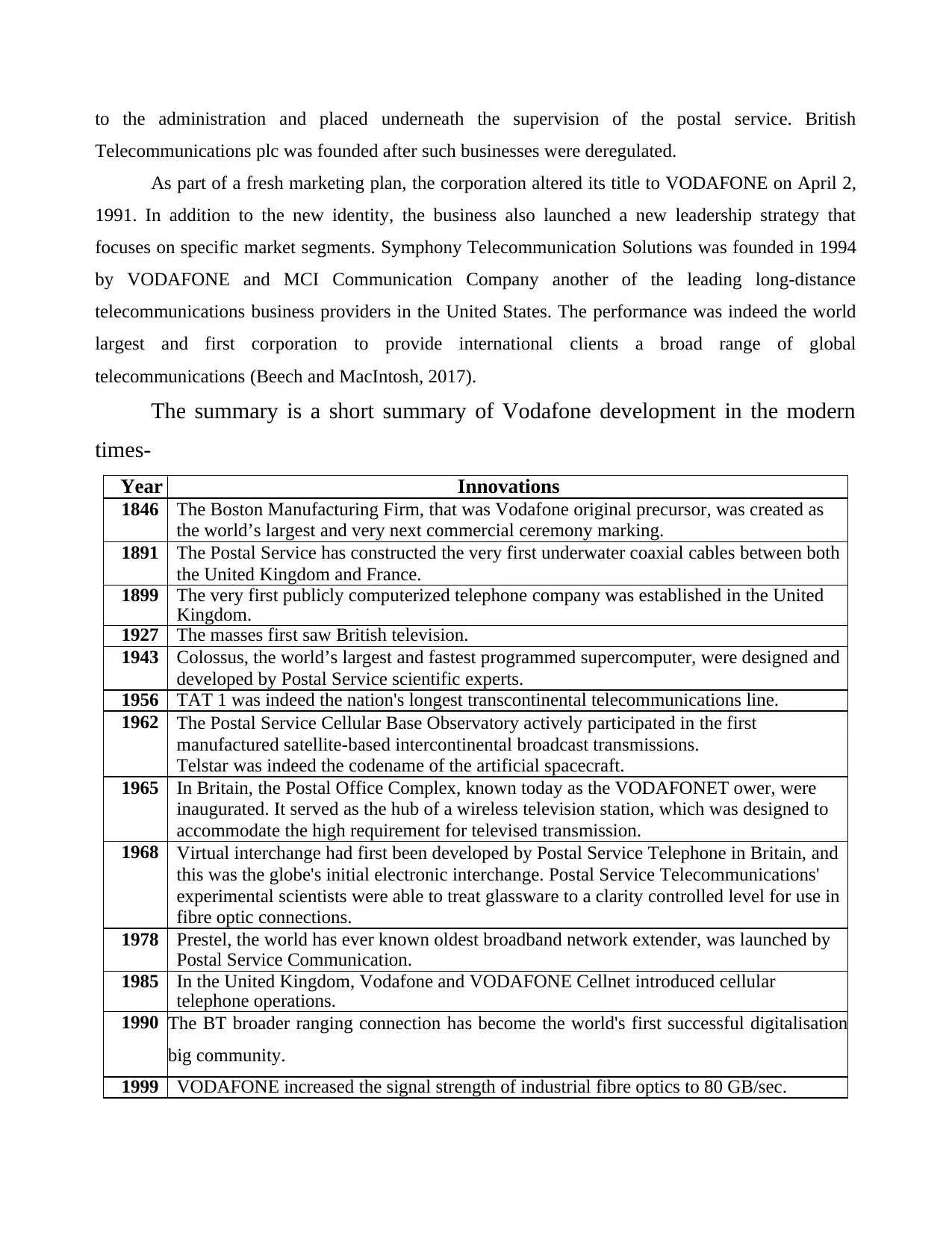
to the administration and placed underneath the supervision of the postal service. British
Telecommunications plc was founded after such businesses were deregulated.
As part of a fresh marketing plan, the corporation altered its title to VODAFONE on April 2,
1991. In addition to the new identity, the business also launched a new leadership strategy that
focuses on specific market segments. Symphony Telecommunication Solutions was founded in 1994
by VODAFONE and MCI Communication Company another of the leading long-distance
telecommunications business providers in the United States. The performance was indeed the world
largest and first corporation to provide international clients a broad range of global
telecommunications (Beech and MacIntosh, 2017).
The summary is a short summary of Vodafone development in the modern
times-
Year Innovations
1846 The Boston Manufacturing Firm, that was Vodafone original precursor, was created as
the world’s largest and very next commercial ceremony marking.
1891 The Postal Service has constructed the very first underwater coaxial cables between both
the United Kingdom and France.
1899 The very first publicly computerized telephone company was established in the United
Kingdom.
1927 The masses first saw British television.
1943 Colossus, the world’s largest and fastest programmed supercomputer, were designed and
developed by Postal Service scientific experts.
1956 TAT 1 was indeed the nation's longest transcontinental telecommunications line.
1962 The Postal Service Cellular Base Observatory actively participated in the first
manufactured satellite-based intercontinental broadcast transmissions.
Telstar was indeed the codename of the artificial spacecraft.
1965 In Britain, the Postal Office Complex, known today as the VODAFONET ower, were
inaugurated. It served as the hub of a wireless television station, which was designed to
accommodate the high requirement for televised transmission.
1968 Virtual interchange had first been developed by Postal Service Telephone in Britain, and
this was the globe's initial electronic interchange. Postal Service Telecommunications'
experimental scientists were able to treat glassware to a clarity controlled level for use in
fibre optic connections.
1978 Prestel, the world has ever known oldest broadband network extender, was launched by
Postal Service Communication.
1985 In the United Kingdom, Vodafone and VODAFONE Cellnet introduced cellular
telephone operations.
1990 The BT broader ranging connection has become the world's first successful digitalisation
big community.
1999 VODAFONE increased the signal strength of industrial fibre optics to 80 GB/sec.
Telecommunications plc was founded after such businesses were deregulated.
As part of a fresh marketing plan, the corporation altered its title to VODAFONE on April 2,
1991. In addition to the new identity, the business also launched a new leadership strategy that
focuses on specific market segments. Symphony Telecommunication Solutions was founded in 1994
by VODAFONE and MCI Communication Company another of the leading long-distance
telecommunications business providers in the United States. The performance was indeed the world
largest and first corporation to provide international clients a broad range of global
telecommunications (Beech and MacIntosh, 2017).
The summary is a short summary of Vodafone development in the modern
times-
Year Innovations
1846 The Boston Manufacturing Firm, that was Vodafone original precursor, was created as
the world’s largest and very next commercial ceremony marking.
1891 The Postal Service has constructed the very first underwater coaxial cables between both
the United Kingdom and France.
1899 The very first publicly computerized telephone company was established in the United
Kingdom.
1927 The masses first saw British television.
1943 Colossus, the world’s largest and fastest programmed supercomputer, were designed and
developed by Postal Service scientific experts.
1956 TAT 1 was indeed the nation's longest transcontinental telecommunications line.
1962 The Postal Service Cellular Base Observatory actively participated in the first
manufactured satellite-based intercontinental broadcast transmissions.
Telstar was indeed the codename of the artificial spacecraft.
1965 In Britain, the Postal Office Complex, known today as the VODAFONET ower, were
inaugurated. It served as the hub of a wireless television station, which was designed to
accommodate the high requirement for televised transmission.
1968 Virtual interchange had first been developed by Postal Service Telephone in Britain, and
this was the globe's initial electronic interchange. Postal Service Telecommunications'
experimental scientists were able to treat glassware to a clarity controlled level for use in
fibre optic connections.
1978 Prestel, the world has ever known oldest broadband network extender, was launched by
Postal Service Communication.
1985 In the United Kingdom, Vodafone and VODAFONE Cellnet introduced cellular
telephone operations.
1990 The BT broader ranging connection has become the world's first successful digitalisation
big community.
1999 VODAFONE increased the signal strength of industrial fibre optics to 80 GB/sec.
⊘ This is a preview!⊘
Do you want full access?
Subscribe today to unlock all pages.

Trusted by 1+ million students worldwide
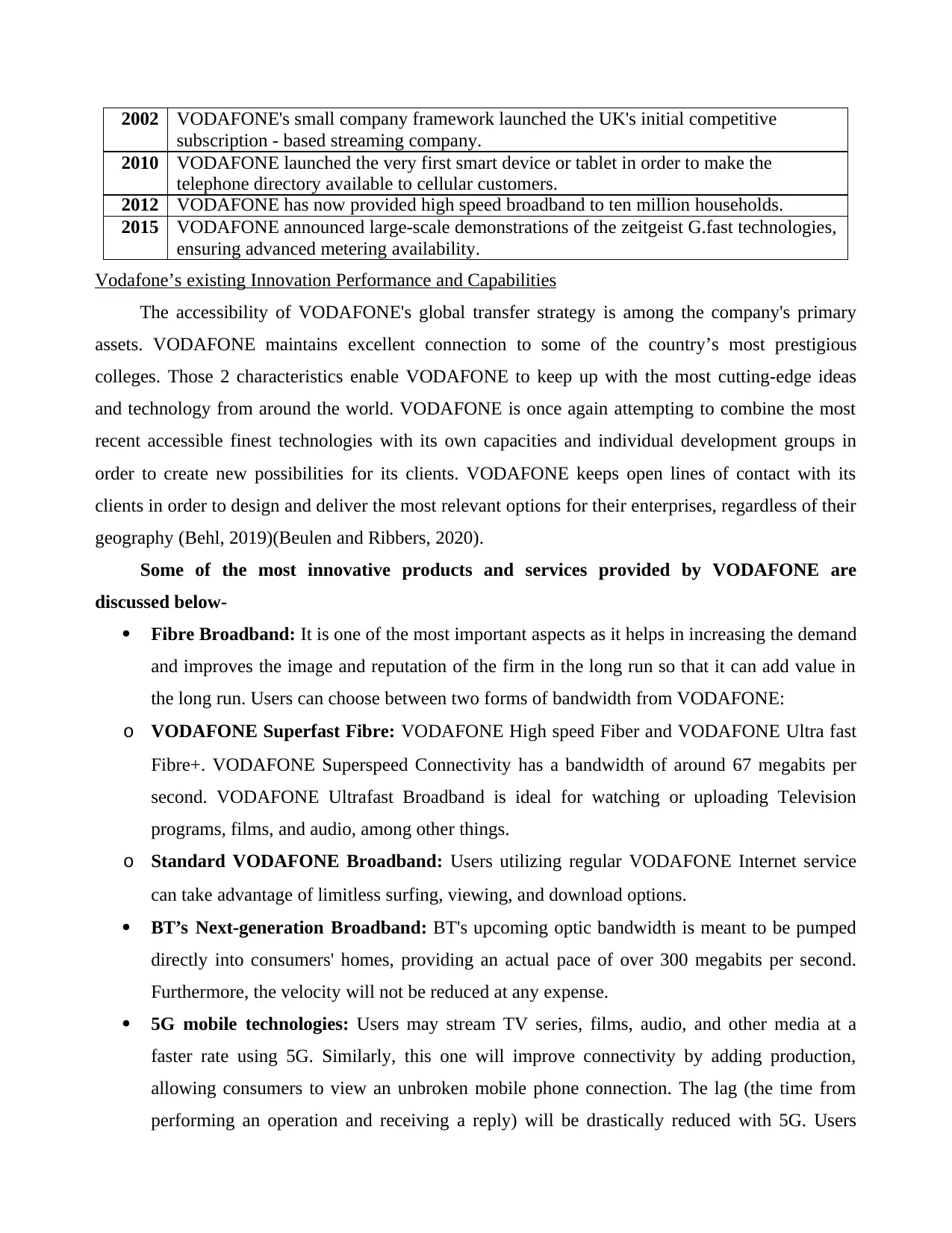
2002 VODAFONE's small company framework launched the UK's initial competitive
subscription - based streaming company.
2010 VODAFONE launched the very first smart device or tablet in order to make the
telephone directory available to cellular customers.
2012 VODAFONE has now provided high speed broadband to ten million households.
2015 VODAFONE announced large-scale demonstrations of the zeitgeist G.fast technologies,
ensuring advanced metering availability.
Vodafone’s existing Innovation Performance and Capabilities
The accessibility of VODAFONE's global transfer strategy is among the company's primary
assets. VODAFONE maintains excellent connection to some of the country’s most prestigious
colleges. Those 2 characteristics enable VODAFONE to keep up with the most cutting-edge ideas
and technology from around the world. VODAFONE is once again attempting to combine the most
recent accessible finest technologies with its own capacities and individual development groups in
order to create new possibilities for its clients. VODAFONE keeps open lines of contact with its
clients in order to design and deliver the most relevant options for their enterprises, regardless of their
geography (Behl, 2019)(Beulen and Ribbers, 2020).
Some of the most innovative products and services provided by VODAFONE are
discussed below-
Fibre Broadband: It is one of the most important aspects as it helps in increasing the demand
and improves the image and reputation of the firm in the long run so that it can add value in
the long run. Users can choose between two forms of bandwidth from VODAFONE:
o VODAFONE Superfast Fibre: VODAFONE High speed Fiber and VODAFONE Ultra fast
Fibre+. VODAFONE Superspeed Connectivity has a bandwidth of around 67 megabits per
second. VODAFONE Ultrafast Broadband is ideal for watching or uploading Television
programs, films, and audio, among other things.
o Standard VODAFONE Broadband: Users utilizing regular VODAFONE Internet service
can take advantage of limitless surfing, viewing, and download options.
BT’s Next-generation Broadband: BT's upcoming optic bandwidth is meant to be pumped
directly into consumers' homes, providing an actual pace of over 300 megabits per second.
Furthermore, the velocity will not be reduced at any expense.
5G mobile technologies: Users may stream TV series, films, audio, and other media at a
faster rate using 5G. Similarly, this one will improve connectivity by adding production,
allowing consumers to view an unbroken mobile phone connection. The lag (the time from
performing an operation and receiving a reply) will be drastically reduced with 5G. Users
subscription - based streaming company.
2010 VODAFONE launched the very first smart device or tablet in order to make the
telephone directory available to cellular customers.
2012 VODAFONE has now provided high speed broadband to ten million households.
2015 VODAFONE announced large-scale demonstrations of the zeitgeist G.fast technologies,
ensuring advanced metering availability.
Vodafone’s existing Innovation Performance and Capabilities
The accessibility of VODAFONE's global transfer strategy is among the company's primary
assets. VODAFONE maintains excellent connection to some of the country’s most prestigious
colleges. Those 2 characteristics enable VODAFONE to keep up with the most cutting-edge ideas
and technology from around the world. VODAFONE is once again attempting to combine the most
recent accessible finest technologies with its own capacities and individual development groups in
order to create new possibilities for its clients. VODAFONE keeps open lines of contact with its
clients in order to design and deliver the most relevant options for their enterprises, regardless of their
geography (Behl, 2019)(Beulen and Ribbers, 2020).
Some of the most innovative products and services provided by VODAFONE are
discussed below-
Fibre Broadband: It is one of the most important aspects as it helps in increasing the demand
and improves the image and reputation of the firm in the long run so that it can add value in
the long run. Users can choose between two forms of bandwidth from VODAFONE:
o VODAFONE Superfast Fibre: VODAFONE High speed Fiber and VODAFONE Ultra fast
Fibre+. VODAFONE Superspeed Connectivity has a bandwidth of around 67 megabits per
second. VODAFONE Ultrafast Broadband is ideal for watching or uploading Television
programs, films, and audio, among other things.
o Standard VODAFONE Broadband: Users utilizing regular VODAFONE Internet service
can take advantage of limitless surfing, viewing, and download options.
BT’s Next-generation Broadband: BT's upcoming optic bandwidth is meant to be pumped
directly into consumers' homes, providing an actual pace of over 300 megabits per second.
Furthermore, the velocity will not be reduced at any expense.
5G mobile technologies: Users may stream TV series, films, audio, and other media at a
faster rate using 5G. Similarly, this one will improve connectivity by adding production,
allowing consumers to view an unbroken mobile phone connection. The lag (the time from
performing an operation and receiving a reply) will be drastically reduced with 5G. Users
Paraphrase This Document
Need a fresh take? Get an instant paraphrase of this document with our AI Paraphraser
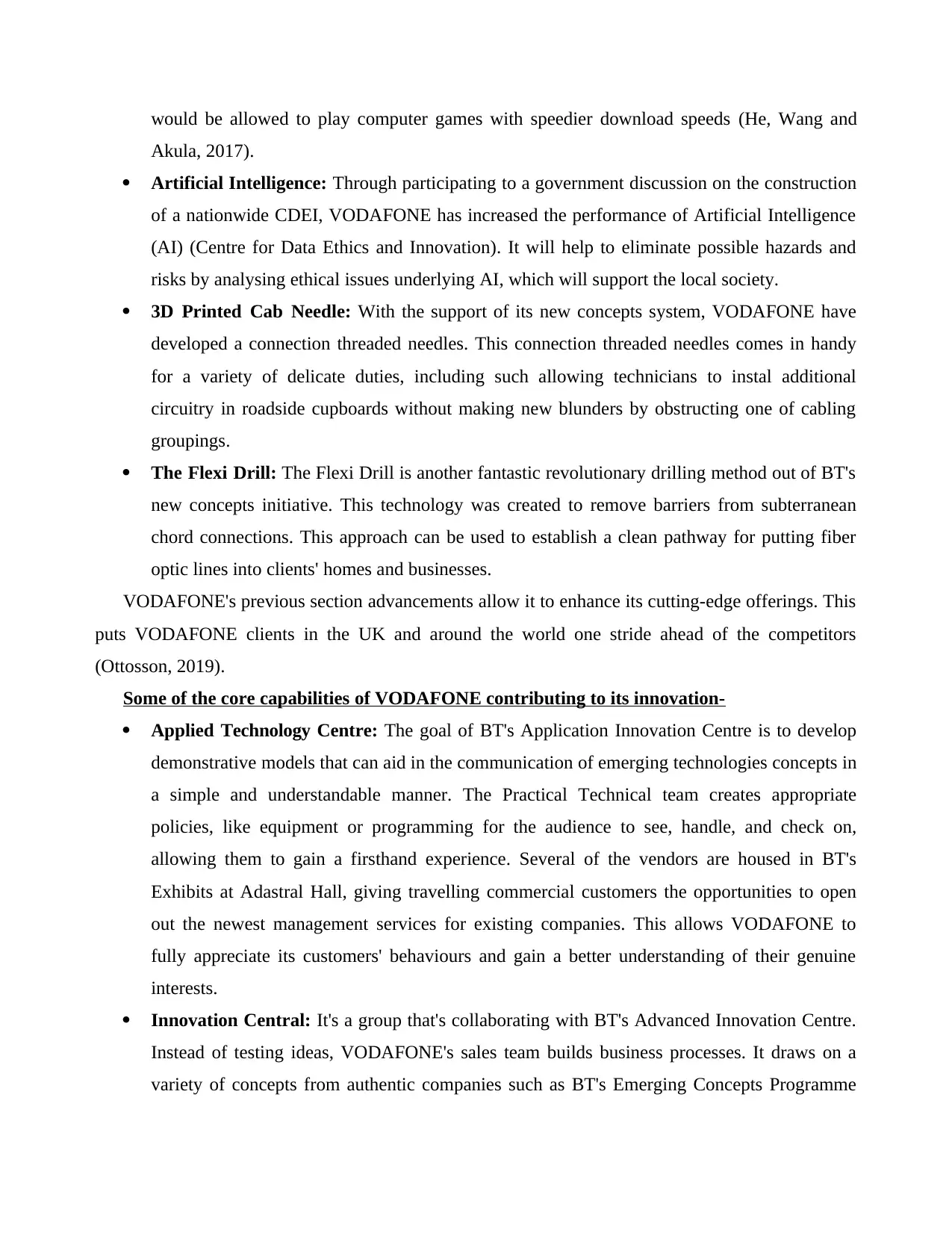
would be allowed to play computer games with speedier download speeds (He, Wang and
Akula, 2017).
Artificial Intelligence: Through participating to a government discussion on the construction
of a nationwide CDEI, VODAFONE has increased the performance of Artificial Intelligence
(AI) (Centre for Data Ethics and Innovation). It will help to eliminate possible hazards and
risks by analysing ethical issues underlying AI, which will support the local society.
3D Printed Cab Needle: With the support of its new concepts system, VODAFONE have
developed a connection threaded needles. This connection threaded needles comes in handy
for a variety of delicate duties, including such allowing technicians to instal additional
circuitry in roadside cupboards without making new blunders by obstructing one of cabling
groupings.
The Flexi Drill: The Flexi Drill is another fantastic revolutionary drilling method out of BT's
new concepts initiative. This technology was created to remove barriers from subterranean
chord connections. This approach can be used to establish a clean pathway for putting fiber
optic lines into clients' homes and businesses.
VODAFONE's previous section advancements allow it to enhance its cutting-edge offerings. This
puts VODAFONE clients in the UK and around the world one stride ahead of the competitors
(Ottosson, 2019).
Some of the core capabilities of VODAFONE contributing to its innovation-
Applied Technology Centre: The goal of BT's Application Innovation Centre is to develop
demonstrative models that can aid in the communication of emerging technologies concepts in
a simple and understandable manner. The Practical Technical team creates appropriate
policies, like equipment or programming for the audience to see, handle, and check on,
allowing them to gain a firsthand experience. Several of the vendors are housed in BT's
Exhibits at Adastral Hall, giving travelling commercial customers the opportunities to open
out the newest management services for existing companies. This allows VODAFONE to
fully appreciate its customers' behaviours and gain a better understanding of their genuine
interests.
Innovation Central: It's a group that's collaborating with BT's Advanced Innovation Centre.
Instead of testing ideas, VODAFONE's sales team builds business processes. It draws on a
variety of concepts from authentic companies such as BT's Emerging Concepts Programme
Akula, 2017).
Artificial Intelligence: Through participating to a government discussion on the construction
of a nationwide CDEI, VODAFONE has increased the performance of Artificial Intelligence
(AI) (Centre for Data Ethics and Innovation). It will help to eliminate possible hazards and
risks by analysing ethical issues underlying AI, which will support the local society.
3D Printed Cab Needle: With the support of its new concepts system, VODAFONE have
developed a connection threaded needles. This connection threaded needles comes in handy
for a variety of delicate duties, including such allowing technicians to instal additional
circuitry in roadside cupboards without making new blunders by obstructing one of cabling
groupings.
The Flexi Drill: The Flexi Drill is another fantastic revolutionary drilling method out of BT's
new concepts initiative. This technology was created to remove barriers from subterranean
chord connections. This approach can be used to establish a clean pathway for putting fiber
optic lines into clients' homes and businesses.
VODAFONE's previous section advancements allow it to enhance its cutting-edge offerings. This
puts VODAFONE clients in the UK and around the world one stride ahead of the competitors
(Ottosson, 2019).
Some of the core capabilities of VODAFONE contributing to its innovation-
Applied Technology Centre: The goal of BT's Application Innovation Centre is to develop
demonstrative models that can aid in the communication of emerging technologies concepts in
a simple and understandable manner. The Practical Technical team creates appropriate
policies, like equipment or programming for the audience to see, handle, and check on,
allowing them to gain a firsthand experience. Several of the vendors are housed in BT's
Exhibits at Adastral Hall, giving travelling commercial customers the opportunities to open
out the newest management services for existing companies. This allows VODAFONE to
fully appreciate its customers' behaviours and gain a better understanding of their genuine
interests.
Innovation Central: It's a group that's collaborating with BT's Advanced Innovation Centre.
Instead of testing ideas, VODAFONE's sales team builds business processes. It draws on a
variety of concepts from authentic companies such as BT's Emerging Concepts Programme
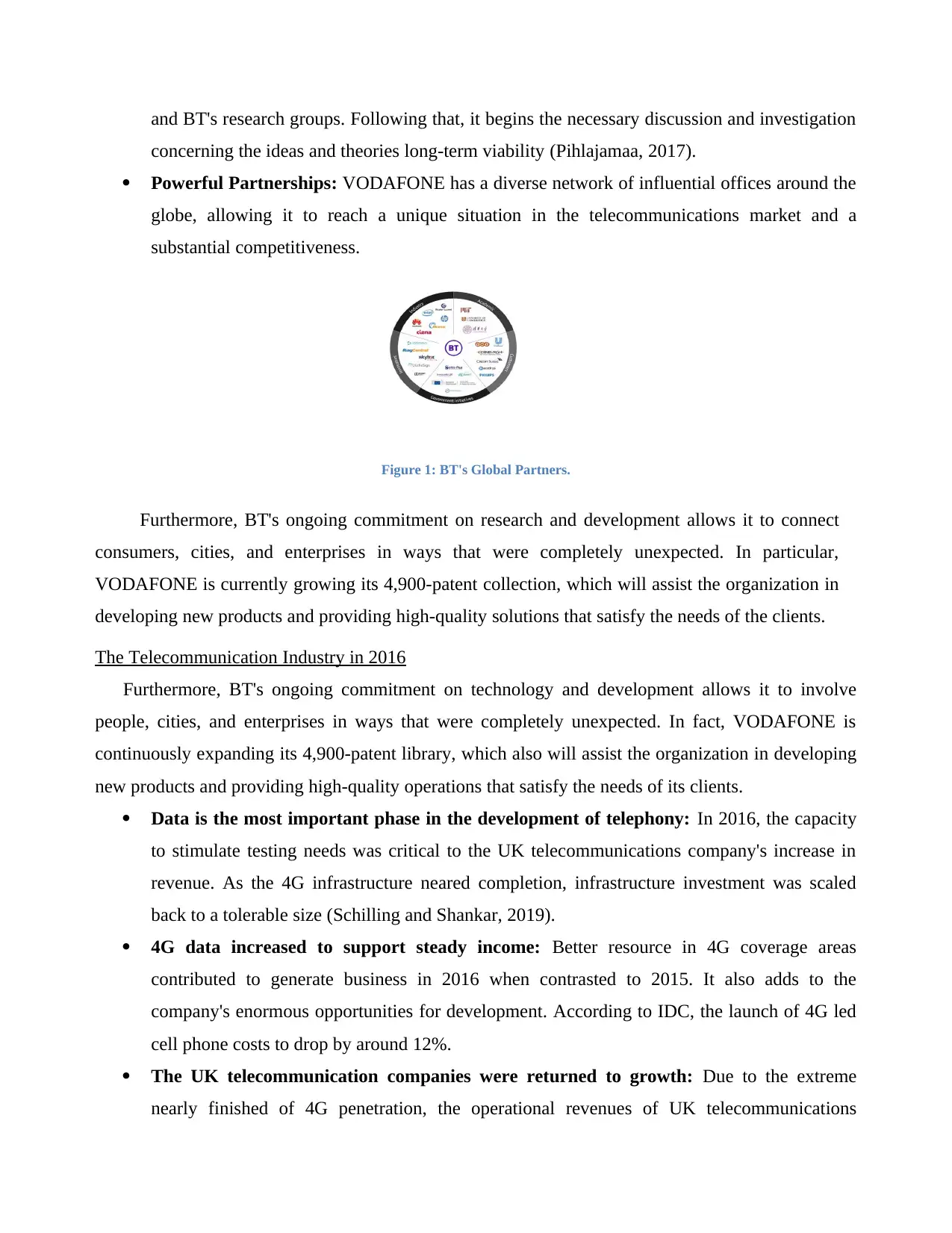
and BT's research groups. Following that, it begins the necessary discussion and investigation
concerning the ideas and theories long-term viability (Pihlajamaa, 2017).
Powerful Partnerships: VODAFONE has a diverse network of influential offices around the
globe, allowing it to reach a unique situation in the telecommunications market and a
substantial competitiveness.
Figure 1: BT's Global Partners.
Furthermore, BT's ongoing commitment on research and development allows it to connect
consumers, cities, and enterprises in ways that were completely unexpected. In particular,
VODAFONE is currently growing its 4,900-patent collection, which will assist the organization in
developing new products and providing high-quality solutions that satisfy the needs of the clients.
The Telecommunication Industry in 2016
Furthermore, BT's ongoing commitment on technology and development allows it to involve
people, cities, and enterprises in ways that were completely unexpected. In fact, VODAFONE is
continuously expanding its 4,900-patent library, which also will assist the organization in developing
new products and providing high-quality operations that satisfy the needs of its clients.
Data is the most important phase in the development of telephony: In 2016, the capacity
to stimulate testing needs was critical to the UK telecommunications company's increase in
revenue. As the 4G infrastructure neared completion, infrastructure investment was scaled
back to a tolerable size (Schilling and Shankar, 2019).
4G data increased to support steady income: Better resource in 4G coverage areas
contributed to generate business in 2016 when contrasted to 2015. It also adds to the
company's enormous opportunities for development. According to IDC, the launch of 4G led
cell phone costs to drop by around 12%.
The UK telecommunication companies were returned to growth: Due to the extreme
nearly finished of 4G penetration, the operational revenues of UK telecommunications
concerning the ideas and theories long-term viability (Pihlajamaa, 2017).
Powerful Partnerships: VODAFONE has a diverse network of influential offices around the
globe, allowing it to reach a unique situation in the telecommunications market and a
substantial competitiveness.
Figure 1: BT's Global Partners.
Furthermore, BT's ongoing commitment on research and development allows it to connect
consumers, cities, and enterprises in ways that were completely unexpected. In particular,
VODAFONE is currently growing its 4,900-patent collection, which will assist the organization in
developing new products and providing high-quality solutions that satisfy the needs of the clients.
The Telecommunication Industry in 2016
Furthermore, BT's ongoing commitment on technology and development allows it to involve
people, cities, and enterprises in ways that were completely unexpected. In fact, VODAFONE is
continuously expanding its 4,900-patent library, which also will assist the organization in developing
new products and providing high-quality operations that satisfy the needs of its clients.
Data is the most important phase in the development of telephony: In 2016, the capacity
to stimulate testing needs was critical to the UK telecommunications company's increase in
revenue. As the 4G infrastructure neared completion, infrastructure investment was scaled
back to a tolerable size (Schilling and Shankar, 2019).
4G data increased to support steady income: Better resource in 4G coverage areas
contributed to generate business in 2016 when contrasted to 2015. It also adds to the
company's enormous opportunities for development. According to IDC, the launch of 4G led
cell phone costs to drop by around 12%.
The UK telecommunication companies were returned to growth: Due to the extreme
nearly finished of 4G penetration, the operational revenues of UK telecommunications
⊘ This is a preview!⊘
Do you want full access?
Subscribe today to unlock all pages.

Trusted by 1+ million students worldwide
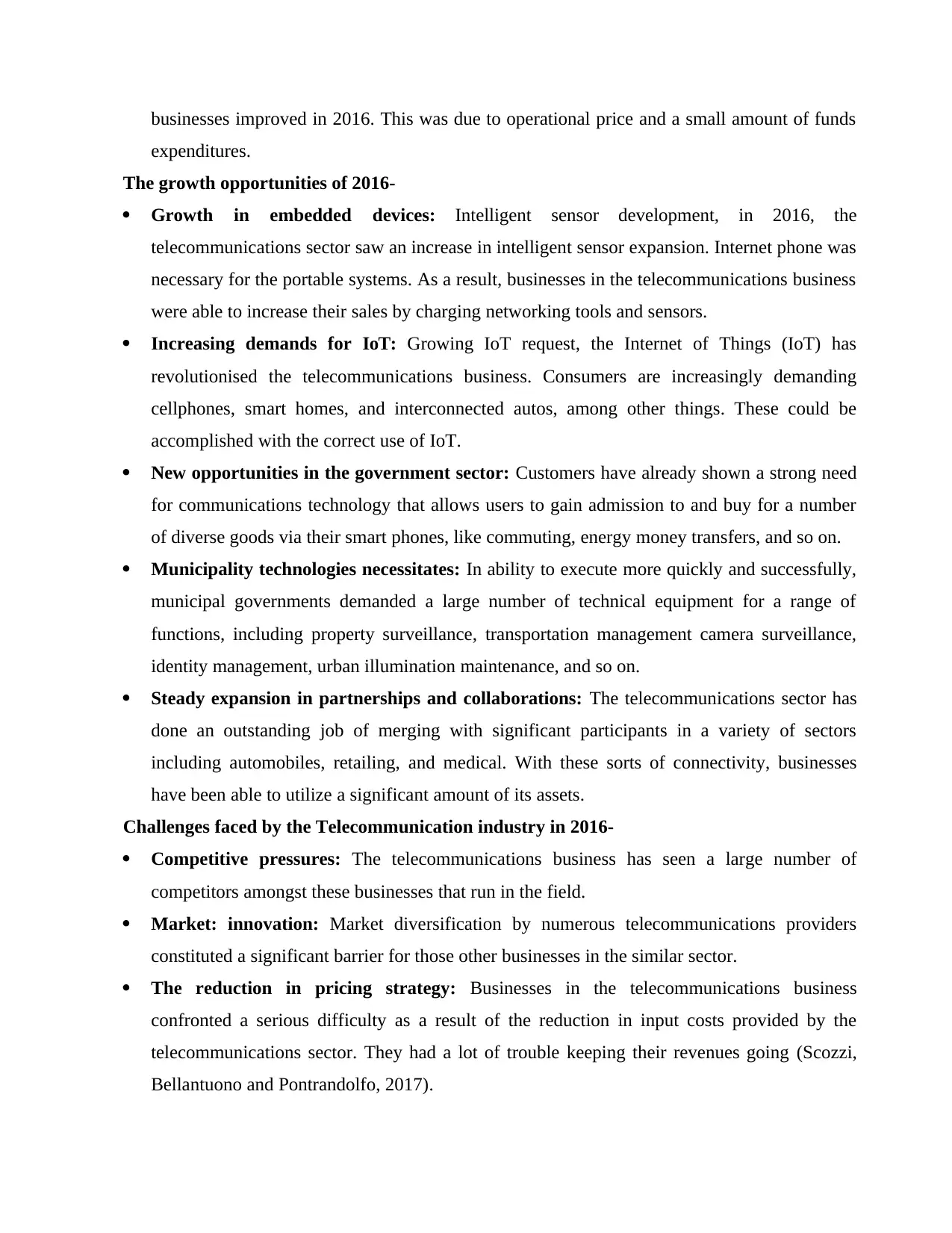
businesses improved in 2016. This was due to operational price and a small amount of funds
expenditures.
The growth opportunities of 2016-
Growth in embedded devices: Intelligent sensor development, in 2016, the
telecommunications sector saw an increase in intelligent sensor expansion. Internet phone was
necessary for the portable systems. As a result, businesses in the telecommunications business
were able to increase their sales by charging networking tools and sensors.
Increasing demands for IoT: Growing IoT request, the Internet of Things (IoT) has
revolutionised the telecommunications business. Consumers are increasingly demanding
cellphones, smart homes, and interconnected autos, among other things. These could be
accomplished with the correct use of IoT.
New opportunities in the government sector: Customers have already shown a strong need
for communications technology that allows users to gain admission to and buy for a number
of diverse goods via their smart phones, like commuting, energy money transfers, and so on.
Municipality technologies necessitates: In ability to execute more quickly and successfully,
municipal governments demanded a large number of technical equipment for a range of
functions, including property surveillance, transportation management camera surveillance,
identity management, urban illumination maintenance, and so on.
Steady expansion in partnerships and collaborations: The telecommunications sector has
done an outstanding job of merging with significant participants in a variety of sectors
including automobiles, retailing, and medical. With these sorts of connectivity, businesses
have been able to utilize a significant amount of its assets.
Challenges faced by the Telecommunication industry in 2016-
Competitive pressures: The telecommunications business has seen a large number of
competitors amongst these businesses that run in the field.
Market: innovation: Market diversification by numerous telecommunications providers
constituted a significant barrier for those other businesses in the similar sector.
The reduction in pricing strategy: Businesses in the telecommunications business
confronted a serious difficulty as a result of the reduction in input costs provided by the
telecommunications sector. They had a lot of trouble keeping their revenues going (Scozzi,
Bellantuono and Pontrandolfo, 2017).
expenditures.
The growth opportunities of 2016-
Growth in embedded devices: Intelligent sensor development, in 2016, the
telecommunications sector saw an increase in intelligent sensor expansion. Internet phone was
necessary for the portable systems. As a result, businesses in the telecommunications business
were able to increase their sales by charging networking tools and sensors.
Increasing demands for IoT: Growing IoT request, the Internet of Things (IoT) has
revolutionised the telecommunications business. Consumers are increasingly demanding
cellphones, smart homes, and interconnected autos, among other things. These could be
accomplished with the correct use of IoT.
New opportunities in the government sector: Customers have already shown a strong need
for communications technology that allows users to gain admission to and buy for a number
of diverse goods via their smart phones, like commuting, energy money transfers, and so on.
Municipality technologies necessitates: In ability to execute more quickly and successfully,
municipal governments demanded a large number of technical equipment for a range of
functions, including property surveillance, transportation management camera surveillance,
identity management, urban illumination maintenance, and so on.
Steady expansion in partnerships and collaborations: The telecommunications sector has
done an outstanding job of merging with significant participants in a variety of sectors
including automobiles, retailing, and medical. With these sorts of connectivity, businesses
have been able to utilize a significant amount of its assets.
Challenges faced by the Telecommunication industry in 2016-
Competitive pressures: The telecommunications business has seen a large number of
competitors amongst these businesses that run in the field.
Market: innovation: Market diversification by numerous telecommunications providers
constituted a significant barrier for those other businesses in the similar sector.
The reduction in pricing strategy: Businesses in the telecommunications business
confronted a serious difficulty as a result of the reduction in input costs provided by the
telecommunications sector. They had a lot of trouble keeping their revenues going (Scozzi,
Bellantuono and Pontrandolfo, 2017).
Paraphrase This Document
Need a fresh take? Get an instant paraphrase of this document with our AI Paraphraser
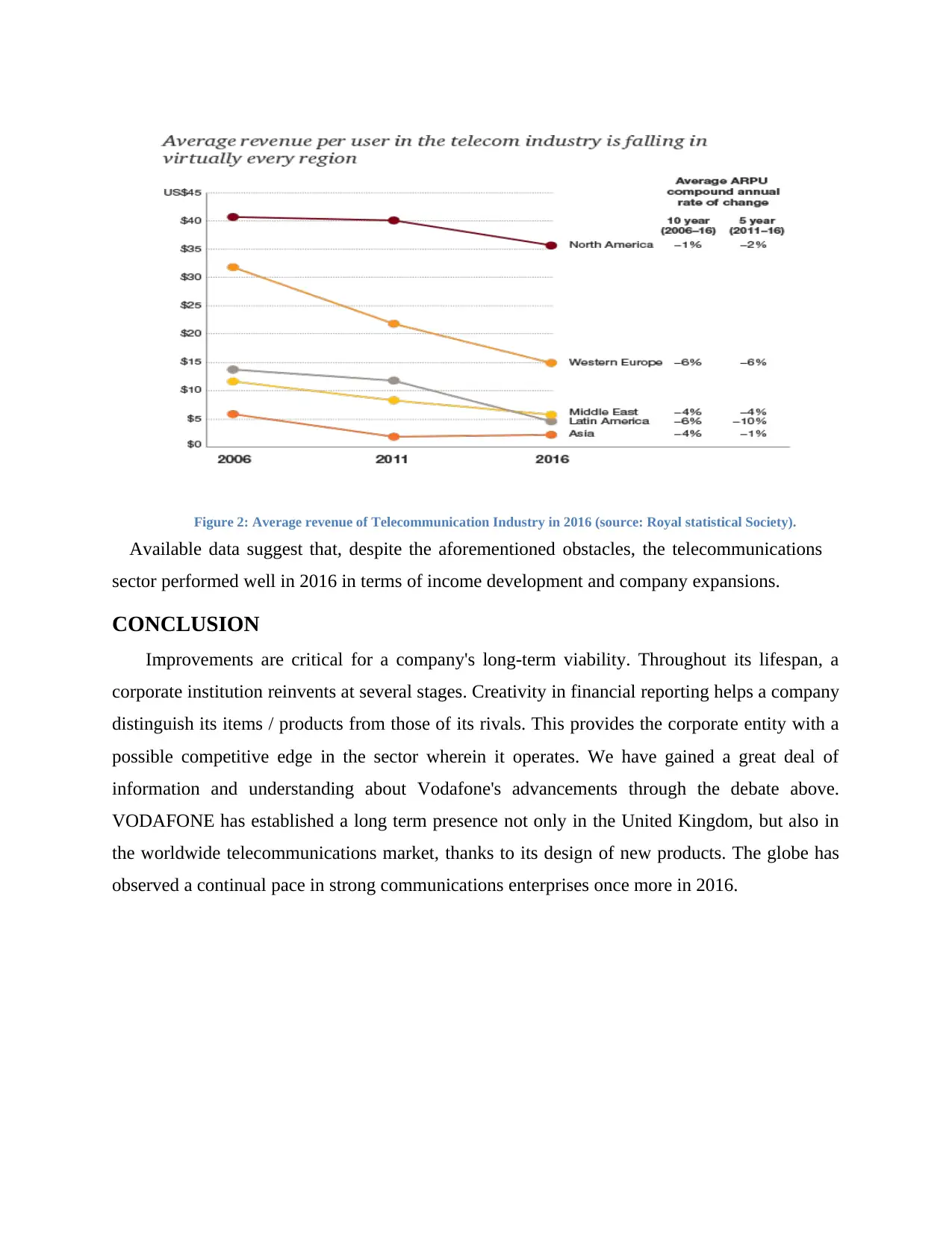
Figure 2: Average revenue of Telecommunication Industry in 2016 (source: Royal statistical Society).
Available data suggest that, despite the aforementioned obstacles, the telecommunications
sector performed well in 2016 in terms of income development and company expansions.
CONCLUSION
Improvements are critical for a company's long-term viability. Throughout its lifespan, a
corporate institution reinvents at several stages. Creativity in financial reporting helps a company
distinguish its items / products from those of its rivals. This provides the corporate entity with a
possible competitive edge in the sector wherein it operates. We have gained a great deal of
information and understanding about Vodafone's advancements through the debate above.
VODAFONE has established a long term presence not only in the United Kingdom, but also in
the worldwide telecommunications market, thanks to its design of new products. The globe has
observed a continual pace in strong communications enterprises once more in 2016.
Available data suggest that, despite the aforementioned obstacles, the telecommunications
sector performed well in 2016 in terms of income development and company expansions.
CONCLUSION
Improvements are critical for a company's long-term viability. Throughout its lifespan, a
corporate institution reinvents at several stages. Creativity in financial reporting helps a company
distinguish its items / products from those of its rivals. This provides the corporate entity with a
possible competitive edge in the sector wherein it operates. We have gained a great deal of
information and understanding about Vodafone's advancements through the debate above.
VODAFONE has established a long term presence not only in the United Kingdom, but also in
the worldwide telecommunications market, thanks to its design of new products. The globe has
observed a continual pace in strong communications enterprises once more in 2016.
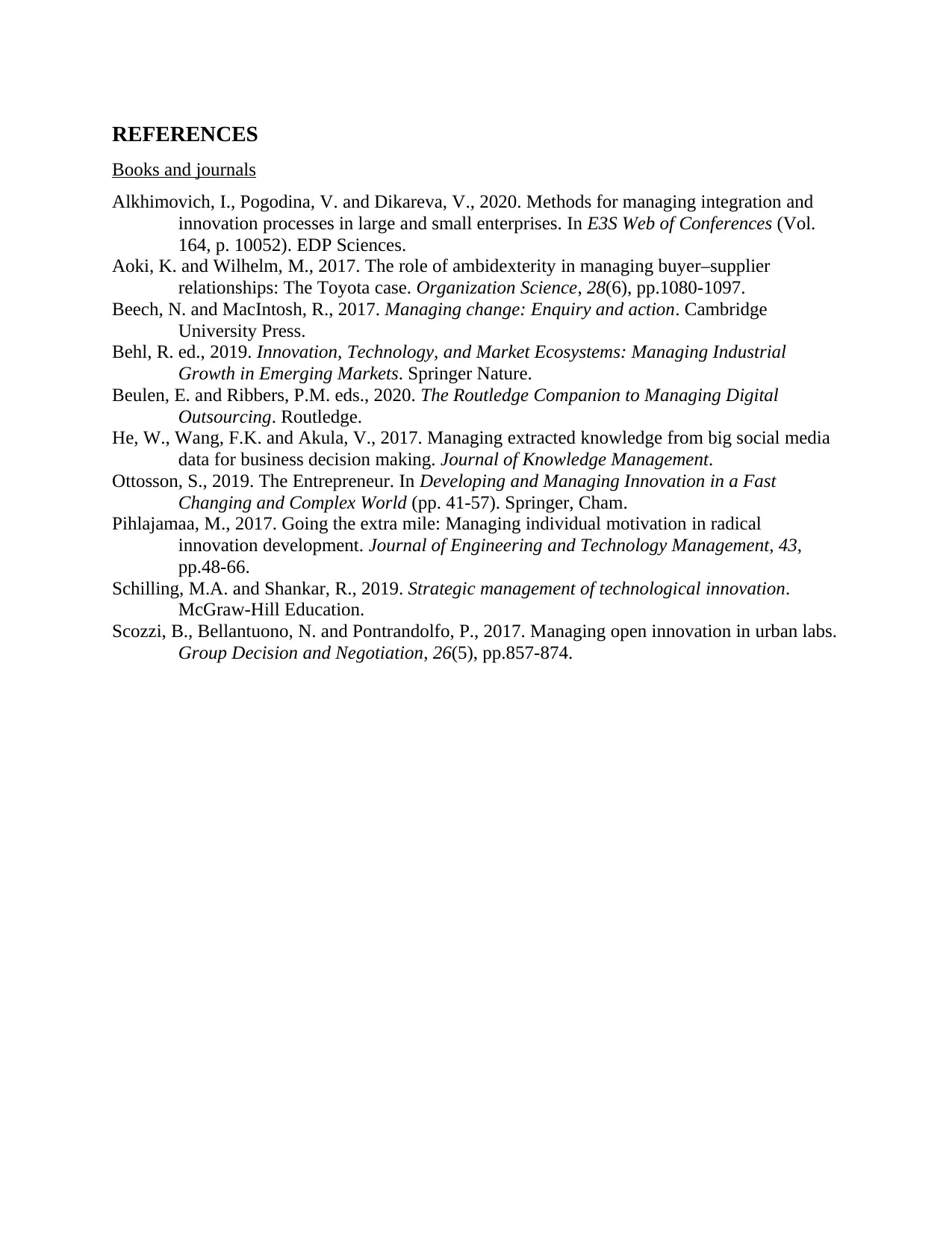
REFERENCES
Books and journals
Alkhimovich, I., Pogodina, V. and Dikareva, V., 2020. Methods for managing integration and
innovation processes in large and small enterprises. In E3S Web of Conferences (Vol.
164, p. 10052). EDP Sciences.
Aoki, K. and Wilhelm, M., 2017. The role of ambidexterity in managing buyer–supplier
relationships: The Toyota case. Organization Science, 28(6), pp.1080-1097.
Beech, N. and MacIntosh, R., 2017. Managing change: Enquiry and action. Cambridge
University Press.
Behl, R. ed., 2019. Innovation, Technology, and Market Ecosystems: Managing Industrial
Growth in Emerging Markets. Springer Nature.
Beulen, E. and Ribbers, P.M. eds., 2020. The Routledge Companion to Managing Digital
Outsourcing. Routledge.
He, W., Wang, F.K. and Akula, V., 2017. Managing extracted knowledge from big social media
data for business decision making. Journal of Knowledge Management.
Ottosson, S., 2019. The Entrepreneur. In Developing and Managing Innovation in a Fast
Changing and Complex World (pp. 41-57). Springer, Cham.
Pihlajamaa, M., 2017. Going the extra mile: Managing individual motivation in radical
innovation development. Journal of Engineering and Technology Management, 43,
pp.48-66.
Schilling, M.A. and Shankar, R., 2019. Strategic management of technological innovation.
McGraw-Hill Education.
Scozzi, B., Bellantuono, N. and Pontrandolfo, P., 2017. Managing open innovation in urban labs.
Group Decision and Negotiation, 26(5), pp.857-874.
Books and journals
Alkhimovich, I., Pogodina, V. and Dikareva, V., 2020. Methods for managing integration and
innovation processes in large and small enterprises. In E3S Web of Conferences (Vol.
164, p. 10052). EDP Sciences.
Aoki, K. and Wilhelm, M., 2017. The role of ambidexterity in managing buyer–supplier
relationships: The Toyota case. Organization Science, 28(6), pp.1080-1097.
Beech, N. and MacIntosh, R., 2017. Managing change: Enquiry and action. Cambridge
University Press.
Behl, R. ed., 2019. Innovation, Technology, and Market Ecosystems: Managing Industrial
Growth in Emerging Markets. Springer Nature.
Beulen, E. and Ribbers, P.M. eds., 2020. The Routledge Companion to Managing Digital
Outsourcing. Routledge.
He, W., Wang, F.K. and Akula, V., 2017. Managing extracted knowledge from big social media
data for business decision making. Journal of Knowledge Management.
Ottosson, S., 2019. The Entrepreneur. In Developing and Managing Innovation in a Fast
Changing and Complex World (pp. 41-57). Springer, Cham.
Pihlajamaa, M., 2017. Going the extra mile: Managing individual motivation in radical
innovation development. Journal of Engineering and Technology Management, 43,
pp.48-66.
Schilling, M.A. and Shankar, R., 2019. Strategic management of technological innovation.
McGraw-Hill Education.
Scozzi, B., Bellantuono, N. and Pontrandolfo, P., 2017. Managing open innovation in urban labs.
Group Decision and Negotiation, 26(5), pp.857-874.
⊘ This is a preview!⊘
Do you want full access?
Subscribe today to unlock all pages.

Trusted by 1+ million students worldwide
1 out of 12
Related Documents
Your All-in-One AI-Powered Toolkit for Academic Success.
+13062052269
info@desklib.com
Available 24*7 on WhatsApp / Email
![[object Object]](/_next/static/media/star-bottom.7253800d.svg)
Unlock your academic potential
Copyright © 2020–2025 A2Z Services. All Rights Reserved. Developed and managed by ZUCOL.





